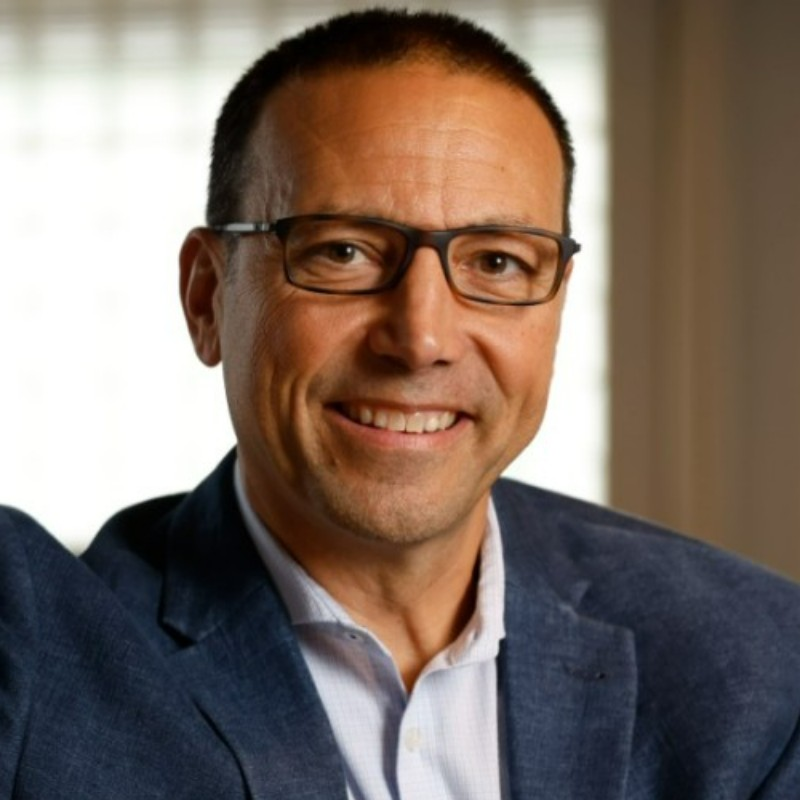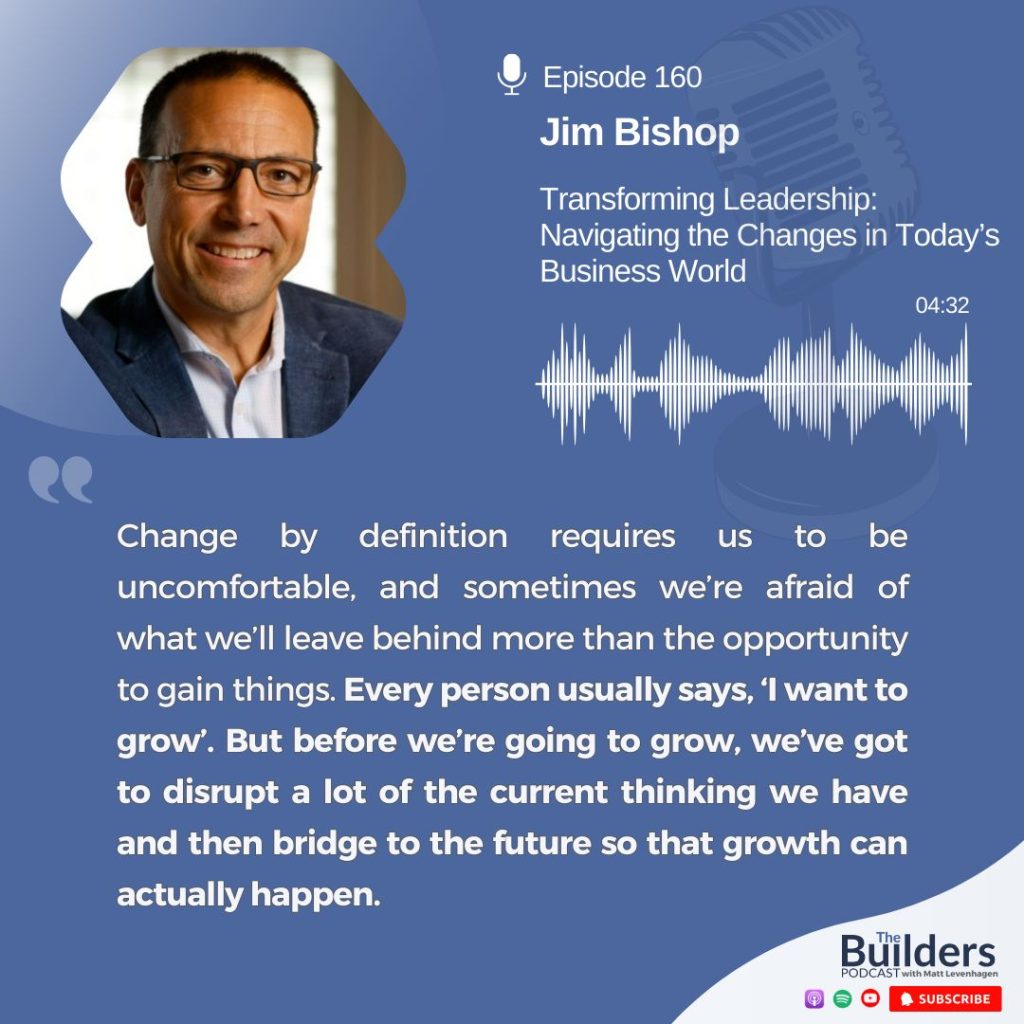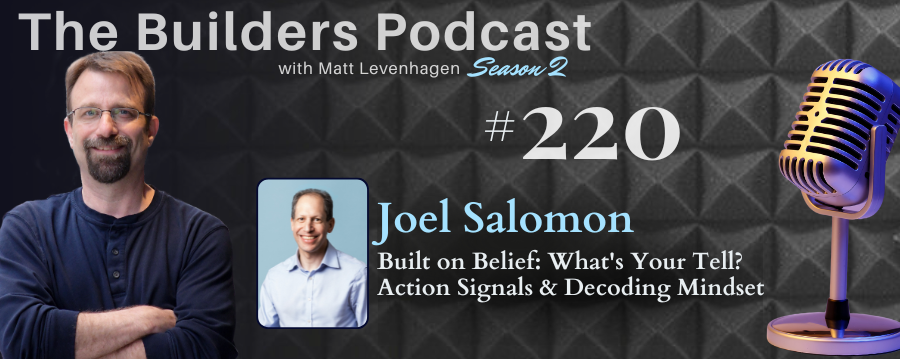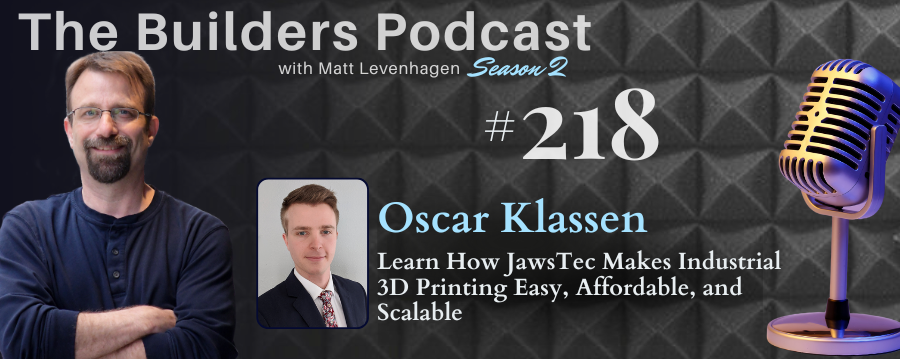
Description:
In this episode of “The Builders,” we are thrilled to have Jim Bishop, a renowned leadership coach with a background as a trained scientist, share his unique insights on transforming leadership and executive coaching's pivotal role. Jim takes us on his journey from his scientific beginnings to becoming an influential figure in human resources and leadership. He discusses his holistic strategy for reshaping work cultures, emphasizing the shift from reactive measures to proactive leadership styles that significantly impact workplace dynamics.
Our conversation with Jim illuminates the essential transition leaders must undergo, especially in the face of challenges brought about by the pandemic. He highlights the importance of adaptability and emotional intelligence in today's rapidly changing business environment. By focusing on midlife leaders, Jim offers guidance on navigating through these shifts with a redefined sense of purpose and connectedness, which is vital for personal and organizational growth.
Key Takeaways:
- Jim Bishop's expertise lies in enhancing work cultures and honing the leadership skills of executives through effective coaching.
- The evolution from traditional training methods to a coaching-centric approach enables leaders to transform their experiences into powerful tools for cultural change.
- The unprecedented disruptions of 2020 have underscored the need for a leadership paradigm shift, prioritizing flexibility and emotional intelligence.
- Bishop's approach is particularly impactful for midlife leaders striving to recalibrate their definitions of success to focus on more meaningful aspects like purpose and legacy.
- Embracing authenticity in leadership fosters a dynamic team environment and culture, paving the way for innovation and improved organizational performance.
This episode not only explores Jim's transformative coaching methods but also delves into how leaders can navigate the complexities of today's business world with resilience and foresight. Join us as we uncover the strategies for building a culture that thrives on innovation, purpose, and connectedness.
Jim Bishop

With over two decades of immersive experience in executive development, corporate leadership and human performance, Jim stands as a beacon of transformative leadership through his business, Conjunction Leadership.
Jim's journey has taken him across the globe, coaching executives, diverse teams and orchestrating the modernization of leadership systems for transforming business units. Having collaborated with industry giants like Eli Lilly, Roche, and Elanco, he recognized the pivotal role of a visionary leader willing to first work on themselves while revitalizing their culture. He empowers executives through executive coaching, corporate culture consulting, and team effectiveness programs, focusing on holistic development within volatile contexts.
THE MEAT OF IT!
- Introduction
- Welcome and episode overview
- Introduction of guest, Jim Bishop
- Jim Bishop's Journey
- From scientist to leadership coach
- The pivot to human resources and leadership
- The Essence of Transformative Leadership
- Proactive vs. reactive leadership styles
- Impact of coaching on work cultures
- Navigating Leadership Challenges
- Adapting to change in uncertain times
- The pandemic's impact on leadership styles
- Midlife Leadership and Redefinition of Purpose
- Challenges faced by midlife leaders
- Navigating change with purpose and connectedness
- Key Strategies for Effective Leadership
- The shift from training to coaching
- Building adaptability and emotional intelligence
- Redefining Success and Legacy
- Beyond conventional markers of success
- The importance of purpose and legacy
- The Role of Authenticity in Leadership
- Authenticity as a catalyst for team dynamics
- Fostering a culture of innovation
- Conclusion
- Recap of key takeaways
- Final thoughts and advice from Jim Bishop
- Closing remarks and episode wrap-up
Click to See Episode Chapters and Timestamp
| Timestamp | Summary |
| 0:00:17 | Introduction and podcast promotion |
| 0:00:40 | Introduction of guest, Jim Bishop |
| 0:01:05 | Jim explains his work in leadership development |
| 0:02:25 | Jim's transition from science to leadership development |
| 0:03:41 | The frustration that led Jim to executive coaching |
| 0:04:59 | Jim's decision to leave corporate America and start his own coaching business |
| 0:06:19 | The challenges and mindset shift of transitioning to entrepreneurship |
| 0:08:16 | The fear and excitement of going out on his own |
| 0:09:11 | Jim's decision to focus on client work rather than managing a large team |
| 0:10:00 | The mindset shift from corporate America to entrepreneurship |
| 0:10:58 | Feeling more secure with multiple clients than relying on one source of income |
| 0:11:57 | Jim discusses the importance of being emotionally present with clients. |
| 0:12:30 | Jim admits that he still struggles at times but is motivated by his sense of purpose and legacy. |
| 0:13:02 | Jim expresses his excitement about his work and the sense of purpose it brings him. |
| 0:13:34 | Jim shares how his career choice influenced his child's college major. |
| 0:14:13 | Matt highlights the value of using personal experience to help others as an entrepreneur. |
| 0:14:36 | Jim reflects on his entrepreneurial journey and the importance of timing and networking. |
| 0:15:19 | Jim emphasizes the significance of maintaining relational connections in business. |
| 0:16:28 | Jim explains the impact of the COVID-19 pandemic on leadership and employee needs. |
| 0:17:52 | Jim discusses the importance of leaders adapting and connecting in the face of uncertainty. |
| 0:18:40 | Matt asks about the changes leaders had to make in response to the pandemic. |
| 0:19:45 | Jim describes how some leaders reacted with fear and relied on their traditional leadership style. |
| 0:20:42 | Jim explains the impact of social injustice issues on employee values and the rise of the “great resignation.” |
| 0:21:55 | Jim highlights the need for leaders to unlearn and embrace a more adaptable and emotionally intelligent approach. |
| 0:23:08 | Jim shares his observations of leaders shifting towards human-centered and adaptable cultures. |
| 0:23:34 | People are starting to relate better in the workplaces and step into autonomy. |
| 0:24:03 | Change requires getting uncomfortable and overcoming fear. |
| 0:25:08 | Executives want employees to be more entrepreneurial, but their behaviors limit it. |
| 0:26:26 | The leader doesn't have to do all the organizing and planning, but can distribute it across the organization. |
| 0:27:41 | Flat organizations promote open communication and coaching at all levels. |
| 0:29:10 | Some companies resist structural change due to leaders' discomfort with distributing power. |
| 0:30:17 | Building a large, connected organization requires maintaining a scrappy and collective culture. |
| 0:32:14 | Coaching leaders helps them embrace change and distribute power, which then impacts the teams. |
| 0:34:27 | Culture is defined as “people like us doing things like this.” |
| 0:35:45 | Jim explains how organizations want to define their culture with words, but it's a process of becoming a better leader. |
| 0:36:48 | Jim discusses how the interpretation of values can vary among employees, leading to a lack of understanding and adherence. |
| 0:37:43 | Jim emphasizes that culture cannot be changed simply by putting words on paper; it requires personal and leadership transformation. |
| 0:38:25 | Matt asks for examples of companies that have successfully implemented cultural change. |
| 0:38:58 | Jim shares a case study of a CEO who transformed the culture of his organization by changing his own behaviors and communication style. |
| 0:41:39 | Jim explains how the CEO's shift in behavior led to increased innovation, better feedback, and improved business results. |
| 0:43:18 | Jim describes his ideal client as midlife executives who are seeking a sense of purpose and fulfillment beyond material success. |
| 0:44:51 | Jim discusses the importance of personal transformation and creating a culture that fosters growth and human connection. |
| 0:46:49 | Jim provides various ways to reach out to him, including his website, LinkedIn, and direct email. |
| 0:47:53 | Jim encourages individuals to set up a call to explore their ideal future and the changes they need to make to achieve it. |
| 0:48:11 | Outro and call to action for viewers. |
| 0:48:30 | Matt mentions that viewers can contact him. |
| 0:48:31 | Sponsor message for unified web design agency. |
| 0:48:58 | Conclusion and thanks for joining. |

Check out these related Episodes:
- Episode 159: Mark Graban – Transforming Mistakes into Positive Outcomes & Continuous Improvement
- Episode 158: AJ Saunders – Easing Into It: How to Successfully Transition Your Business to Ecommerce
- Episode 157: Carrington Crothers – Mastering the Art of Photography: Beyond Stock Images




